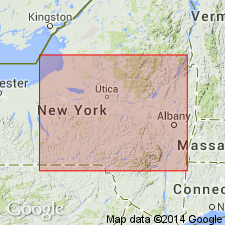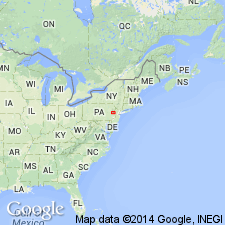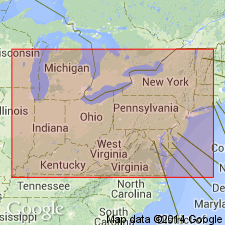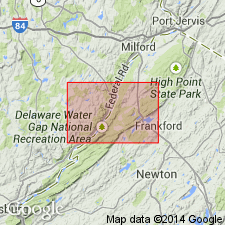
- Usage in publication:
-
- New Scotland beds
- Modifications:
-
- Named
- Dominant lithology:
-
- Limestone
- AAPG geologic province:
-
- Appalachian basin
Summary:
Name New Scotland beds or limestone introduced for shaly limestone exposed at town of New Scotland, Albany Co., NY. Underlies Becraft limestone and overlies Coeymans limestone. Included in Helderbergian group. Equivalent to Delthyris shaly limestone (the paleontologic name for these strata). Age is Early Devonian.
Source: GNU records (USGS DDS-6; Reston GNULEX).

- Usage in publication:
-
- New Scotland Formation*
- Modifications:
-
- Revised
- AAPG geologic province:
-
- Appalachian basin
Summary:
New Scotland Formation of Helderberg Group. Divided into (in ascending order) Maskenozha and Flatbrookville Members (both new). Formerly New Scotland Limestone which remains in good usage outside report area (northeastern Pennsylvania, New Jersey, and southeasternmost New York). Age is Early Devonian.
Source: Changes in stratigraphic nomenclature, 1967 (USGS Bull. 1274-A, p. A14).

- Usage in publication:
-
- New Scotland Formation
- Modifications:
-
- Revised
- AAPG geologic province:
-
- Appalachian basin
Summary:
Beds A and B of the newly named Bald Hill Bentonite Beds occur within the New Scotland Formation in PA and WV and within the correlative Corriganville Limestone in MD. Bed C occurs near the base of the overlying Mandata in all three states. In NY, Beds A, B, and C occur within the middle member of the Kalkberg Limestone.
Source: GNU records (USGS DDS-6; Reston GNULEX).

- Usage in publication:
-
- New Scotland Formation
- Modifications:
-
- Overview
- AAPG geologic province:
-
- Appalachian basin
Summary:
New Scotland Formation of Helderberg Group is mapped in northwestern NJ. Upper section is dark-gray, siliceous, laminated shale containing medium-dark-gray, very fine-grained limestone pods and scattered beds and lenses of medium-gray, fine-grained argillaceous, fossiliferous limestone. Limestone contains small, dark-gray chert nodules. Lower section is medium-dark-gray, siliceous, calcareous, fossiliferous shale containing beds and lenses of medium-gray, fine-grained, argillaceous, very fossiliferous limestone. Contains nodules, lenses and local irregular beds of dark-gray chert. Total thickness of formation is approximately 75 ft. Lower contact with the Coeymans Formation of Helderberg is abrupt, at the top of a calcareous quartz sandstone. Underlies Minisink Limestone of Helderberg Group. Age is Early Devonian.
Source: GNU records (USGS DDS-6; Reston GNULEX).
For more information, please contact Nancy Stamm, Geologic Names Committee Secretary.
Asterisk (*) indicates published by U.S. Geological Survey authors.
"No current usage" (†) implies that a name has been abandoned or has fallen into disuse. Former usage and, if known, replacement name given in parentheses ( ).
Slash (/) indicates name conflicts with nomenclatural guidelines (CSN, 1933; ACSN, 1961, 1970; NACSN, 1983, 2005, 2021). May be explained within brackets ([ ]).

